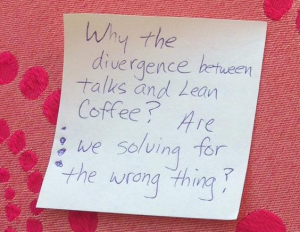 It's been a few weeks now since Agile2015 wrapped up. So, what's next?
It's been a few weeks now since Agile2015 wrapped up. So, what's next?
I made a plan this year that I was going to spend a lot more time outside of the planned sessions of the annual Agile Alliance conference, of which this was my fourth. When I attended back in 2012, I went to sessions by the "who's who" in the Agile space. To get as much value as possible, I attended as many scheduled sessions as possible. The only exception to that schedule was I wanted to attend some Lean Coffees.
Each year, I have returned to the Gaylords for the annual Agile Alliance conference. Texas, Tennessee, Florida, Washington DC... In that short time, something changed. Those things that I believe, as they relate to Lean, Agile, and Transformations in the Enterprise have evolved. Those people who I saw speak back in 2012 are saying the same things. Honestly, what they are saying just isn't as compelling as it once was.
The Problem of BDUF
Agilists talk about how bad it is to have a Big Design Up Front (BDUF).
"Critics (notably those who practice agile software development) argue that BDUF is poorly adaptable to changing requirements and that BDUF assumes that designers are able to foresee problem areas without extensive prototyping and at least some investment into implementation... ~Wikipedia"
Each year, a bunch of super smart people go through a few thousand submissions for the coming event, in the hope of shaping a conference that people will attend and enjoy. The decisions are made months in advance on exactly what talks/workshops will happen. A lot of work goes into this effort (I know because I was a reviewer one year). This is all done in a vacuum. Honestly, those who are reviewing the sessions don't know what the attendees will perceive as valuable. So, they can't vet the most valuable sessions. This year, I found the conference was heavy on Agile fundamentals (this was a conversation at one of the lean coffees at the conference). Now, this may not be a bad thing. Maybe the Agile Alliance has a target market of those with less than three years working in the domain. But what about those with more experience in the Agile space? Where will we find our valuable sessions at the conference?
Solving the problem with Emergent Design
I know you can't please everyone, but each year I have found fewer topics so compelling that I want to sit there for an hour and listen to someone. I have learned to get up and walk out as quickly as possible, when I discover the session is not going to provide me the value I had hoped. Fortunately this year, I found that Lean Coffee, Open Jam, and the Stalwarts sessions gave me almost an entire conference-week of very valuable and satisfying conversations and learning. Did I find a few compelling sessions this year? Yes. Is the value of the planned session diminishing year over year for me? Yes. Will I spend even more time in the Lean Coffee and Open Jam space next year? Yes, absolutely!
The Divergence
I am certainly not poo-pooing the Agile Alliance or the people who put on the conference. I'm sure there are people out there who think I am. That's not what I'm doing. Those people do a hell of a good job, year after year. I look forward to going to the conference in Atlanta next year. But, there is a split that I'm seeing. I didn't like the big planning upfront this year or at other local conferences. So, I stood up my own conference: Agile Baltimore Unconference. Now, this post isn't about self-promoting my event. It's about the divergence I'm seeing. I found it interesting to discover that if you have an Open Space (an unconference method) event, the sponsor request will take a different path within the Agile Alliance (who are now a sponsor of the Agile Baltimore Unconference). I found it interesting the attendees of the Agile2015 Lean Coffees and Open Jam agreed that if you wanted more advanced topics, you weren't going to find many in the planned sessions.
Agile Baltimore or Agile2015+ Unconference
So, what if the Agile Alliance had an Unconference? Imagine a whole day of conversations, like the ones you had between sessions, at coffee, lunch, or over drinks. Wouldn't that be awesome? Do you think that is the direction we're going? As a community, is the big plan up front more valuable than the conversations or the information we're trying to distribute?
Again, I'd like to thank the Agile Alliance for sponsoring the upcoming Agile Baltimore Unconference.
What: Agile Baltimore Unconference
When: Monday, October 12, 2015 7:30 AM - 7:00 PM (Eastern Time)
Where: ETC Incubator, 101 N Haven St, Baltimore, Maryland 21224
How: To learn more or to register, go to http://www.agilebaltimore.org







